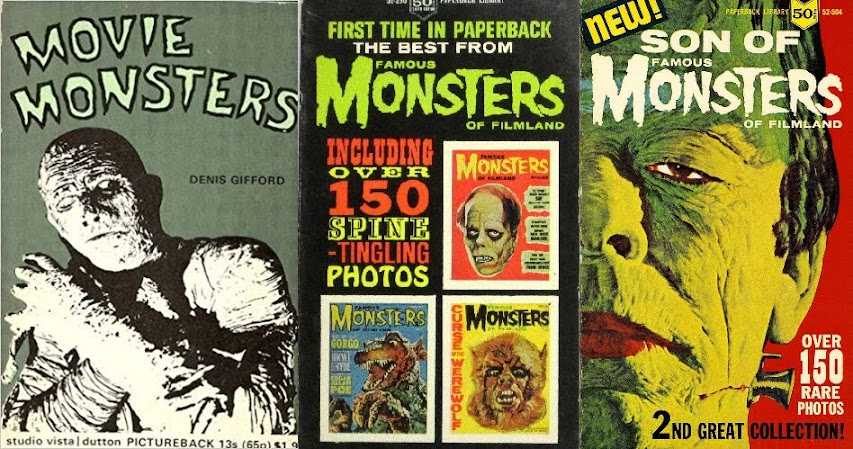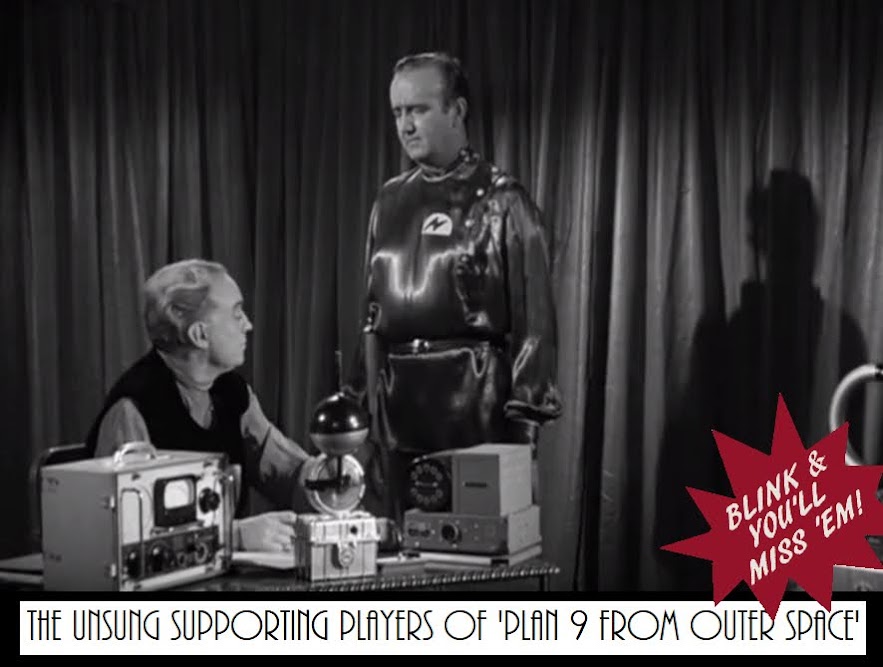 |
| Laraine Newman (fourth from left, in usherette costume) heads the cast of The Canned Film Festival. |
Let's face it. Old B-movies, especially those of the horror and sci-fi variety, are inherently funny to many viewers. The plots are often far-fetched, the dialogue improbable, the acting dubious, and the special-effects shoddy. Audiences see these films, and their first instinct is to laugh. And yet the characters onscreen are required to take themselves and their situations very seriously indeed. Which, in turn, makes the movies even funnier.
This is the central truth that has fueled the Ed Wood cult for decades. People come to his movies mainly to laugh at their cheapness and naivete. I've been in these theaters. I've heard the laughter. I've done some of the laughing myself. I couldn't help it.
 |
| Vampira: One of the early horror hosts. |
This phenomenon hardly began with the publication of Harry and Michael Medved's The Golden Turkey Awards in 1980. Television horror hosts have been poking fun—and not always in a gentle way—at sci-fi and horror movies since the 1950s and 1960s. One such wisecracking host was Maila "Vampira" Nurmi, who actually appeared in Ed Wood's Plan 9 from Outer Space (1959) and forever after became associated with the director, much to her embarrassment. In Tim Burton's Ed Wood (1994), Eddie complains that Vampira "doesn't show [the movies] the proper respect."
A certain level of kidding is present, too, in the fan magazines of that period. Rudolph Grey maintains that the Ed Wood cult really began in the pages of Forrest J. Ackerman's Famous Monsters of Filmland magazine, where stills from Eddie's movies would run with captions like "one of the un-best movies of all time." Ackerman's readers were the ones who grew up and and alerted the authors of The Golden Turkey Awards to the existence of Edward D. Wood, Jr. and Plan 9.
The Medved book brought this type of humor into the mainstream, and it introduced Ed Wood's movies to a larger audience, too The "bad movie" cult thrived in the 1980s as never before. In 1982, Paramount released It Came From Hollywood, a compilation of vintage "Grade Z" movie clips hosted by a gaggle of comedians, including Gilda Radner and Dan Aykroyd from Saturday Night Live. That film devoted an entire segment to Eddie. In 1988, Mystery Science Theater 3000 debuted as a local program in Minneapolis before going national on Comedy Central the next year. That series eventually dissected several of Eddie's films, including Bride of the Monster (1955), The Violent Years (1956), and The Sinister Urge (1960).
 |
| The Canned Film Festival |
A less-heralded, indeed largely forgotten, example of this trend was a syndicated series called The Canned Film Festival. Lasting for 13 wacky weeks in the summer of 1986, it was hosted by another Saturday Night Live veteran, Laraine Newman, whose thin frame and Los Angeles twang had typecast her somewhat as a Valley Girl ditz. The show's title served as both a pun on the famed Cannes Film Festival and a reference to the program's sponsor, Dr. Pepper. The soft drink maker had long prided itself on its eccentricity (see the "I'm a pepper!" spots with David Naughton), so underwriting a series built around wild and woolly B-movies somehow seemed a natural fit for the brand.
At the time, Dr. Pepper was running its own ambitious Mad Max-inspired science-fiction ad campaign. That campaign, like The Canned Film Festival itself, was devised by a New York-based marketing firm called Young & Rubicam. This company had handled Dr. Pepper's marketing since 1969. Y&R finally lost the Dr. Pepper account in 2008 after nearly 40 years of truly creative, memorable advertising.
At the time, Dr. Pepper was running its own ambitious Mad Max-inspired science-fiction ad campaign. That campaign, like The Canned Film Festival itself, was devised by a New York-based marketing firm called Young & Rubicam. This company had handled Dr. Pepper's marketing since 1969. Y&R finally lost the Dr. Pepper account in 2008 after nearly 40 years of truly creative, memorable advertising.
If The Canned Film Festival hadn't debuted two years before Mystery Science Theater 3000, one might almost be tempted to call it an MST3K ripoff. Like that series, Canned has its own high-concept premise, explained at length in the introduction. Laraine Newman plays Laraine, the owner of a small, struggling movie theater called the Ritz in the fictional town of Limekirk, Texas. She runs the place with her reclusive, rarely-seen mother—Mom running the projector, daughter serving as usherette—but business is lousy. At first, Laraine tries to lure customers by adding laundry facilities and selling eccentric snacks at the concession stand. (Chocolate Covered Lug Nuts, anyone?)
An announcer (Bill St. James, uncredited) informs us: "And that didn't work, so she gathered together a collection of the strangest, silliest, most unusual movies ever made, stocked every refreshment imaginable, and she called it The Canned Film Festival! Will she pull it off? Will Laraine and her mom survive?" Based on the show's short shelf life, the answer was obviously no. While MST3K lasted a decade and has recently been revived on Netflix, Canned came and went in a few months. The two series covered a lot of the same territory. Of the 13 films shown on Canned, seven wound up on MST3K. And one of those was Ed Wood's Bride of the Monster.
 |
| Tor: The ultimate door prize? |
At the outset of the show, Laraine Newman is proudly handing out genuine Tor Johnson masks from Don Post Studios. Perky, naive Becky (Laura Galusha, whose resume is largely barren) is freaked out by Tor's visage, while gossipy Doris (Rossetter) is thoroughly unimpressed. Two nerds, talkative Fitzy (Garner) and taciturn Chan (Nee), are more enthusiastic. Laraine's character, meanwhile, can be described as a trivia-spouting film fanatic. She describes the feature to her patrons this way: "Tonight's film is Bride of the Monster, written and directed in 1953 by the legendary Edward Wood. It stars Bela Lugosi. You know, he was hoping this movie would launch his comeback, but it never did." And, yes, the film really was made in 1953 despite not being released until 1955. Good catch, Canned Movie Festival.
Both the announcer and Fitzy point out that Bride of the Monster was Bela's "last speaking role." This is something I hadn't considered, but it turns out to be true. After Bride, Bela appeared in The Black Sheep (1956) for director Reginald Le Borg but was not given any dialogue. His final role in Plan 9 was obviously silent. So, yeah, Bride is the last time Bela speaks in a movie. After staggering out of the theater, Fitzy and Chan debate what Bela's ultimate line actually is. Chan seems to think it was "AWWWWW!" but Fitzy insists it was more like "AHHHHHH!" ("AWWWWW!" was Tor's last line, Fitzy clarifies.)
Later, swapping trivia with Fritzy and Chan, Laraine drops this bombshell: "When [the filmmakers] rented the sea monster from the Disney studios for this film, they didn't have enough money to rent the motor to make it move. They had to make it move themselves!" Where she got the part about Disney, I have no idea. Maybe writers Ken Smith and Mike Wilkins thought the monster was from Disney's 20,000 Leagues Under the Sea (1954). For the record, the rubber octopus came from Republic's Wake of the Red Witch (1948) with John Wayne.
In a lot of ways, The Canned Film Festival serves as a snapshot of the Ed Wood cult as it stood in 1986. This was six years before Rudolph Grey's Nightmare of Ecstasy: The Life and Art of Edward D. Wood, Jr., the first comprehensive book about the director, so there were a lot of rumors, half-truths, and urban legends circulating about Eddie. Some of those stories are so entertaining, they've become permanent parts of the myth. When Fitzy mentions Tor Johnson breaking Ed's toilet seats, Laraine counters with: "He directed all his films wearing women's clothes! And no one knows where he's buried!" The toilet seat thing appears to be true, but the rest is hooey.
The show also tries to discuss Wood's movie from a critical/analytical standpoint. Fitzy opines that Bride "shows how absolute power corrupts absolutely. And never let a stranger strap a spaghetti strainer to your head!" For her part, Becky identifies with the Janet Lawton character. She's going through a rough patch with her boyfriend Jack (F. Richards Ford, largely absent from this episode) and offers this feminist interpretation of Bride of the Monster:
I see a woman who has taken charge of her own destiny. Well, she's engaged to Tony, but she goes out on her own. She's not afraid. She... she turns down dinner, and she goes to the swamp! The forbidden swamp! The swamp that everybody's afraid of! Oh, the men don't like the swamp. The men stand around outside the swamp, smoking cigarettes and talking about the weather and how much they don't like the swamp. But she... she rushes right in! Maybe that's what I have to learn! I have to learn how to go into the swamp all by myself and find out what it is I'm really afraid of. And then what? Go home and change and go out to dinner. (laughs) Is that what it's really all about?
The female characters wander away from the movie from time to time to check on their laundry. The Canned Film Festival does show its age during a scene when Doris comments about Chan: "For a Chinaman, he doesn't know diddly about laundry!" Becky helpfully keeps her pal updated on the plot: "Tor Johnson throws a scientist to the sea monster, then he took the girl up to Bela Lugosi's room." And just like Johnny Depp in Ed Wood, actress Laura Galusha attempts to imitate Bela's hypnotic hand gestures.
 |
| "I and my so called droogs wore our maskies." |
The episode ends on a hopeful note. Lovers Becky and Jack have reunited, and Laraine has even persuaded her hermit-like mother to come out of hiding and play the calliope at a nearby benefit show, though the diminutive old lady hides her face behind a Tor Johnson mask before slowly exiting the Ritz. The other characters all don their Tor masks and cheerfully follow her, except Doris, who doesn't want to mess up her pristine hairdo.
The Canned Film Festival was clearly a non-starter for both Dr. Pepper and Laraine Newman, so there was no second season. Maybe it was difficult for producers to sell an oddball, 90-minute program like this to stations across America. The show is nowhere near as well known as Mystery Science Theater 3000, and it lags behind such comparable series as Mad Movies with the L.A. Connection (1985-1986), Jay Ward's Fractured Flickers (1963-1964), and Joe Bob Briggs' MonsterVision (1991-2000) in terms of popularity.
Judging by its highly detailed Wikipedia page, however, The Canned Film Festival obviously has its fans. And it's pretty easy to see why. The series offered up some memorable B-movies at a time when those were not readily accessible on home video. The wraparound segments, while not staggeringly brilliant, are quite amiable. Laraine Newman is clearly having fun here; she probably didn't get a lot of opportunities to play know-it-all film buffs. The Bride of the Monster episode is a terrific time capsule item. Besides the movie and the vignettes, it includes a variety of truly loopy, sci-fi-inspired Dr. Pepper spots plus some promos for Tobe Hooper's The Texas Chainsaw Massacre 2 (1986). And keep an eye peeled for a Sports Illustrated ad with a very young Rob Morrow.























